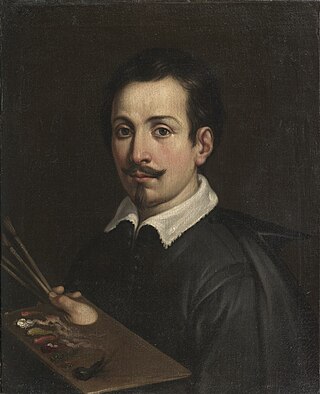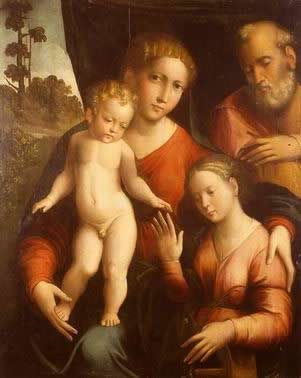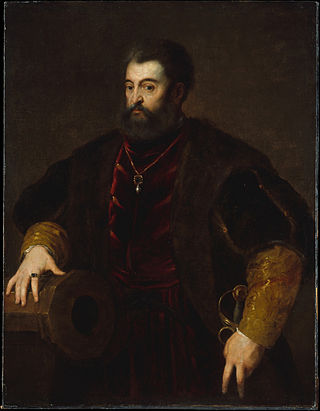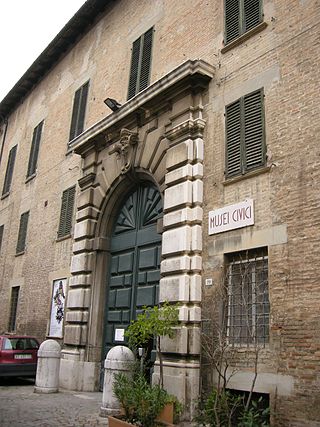
Agostino Carracci was an Italian painter, printmaker, tapestry designer, and art teacher. He was, together with his brother, Annibale Carracci, and cousin, Ludovico Carracci, one of the founders of the Accademia degli Incamminati in Bologna. Intended to devise alternatives to the Mannerist style favored in the preceding decades, this teaching academy helped propel painters of the School of Bologna to prominence.

Guido Reni was an Italian painter of the Baroque period, although his works showed a classical manner, similar to Simon Vouet, Nicolas Poussin, and Philippe de Champaigne. He painted primarily religious works, but also mythological and allegorical subjects. Active in Rome, Naples, and his native Bologna, he became the dominant figure in the Bolognese School that emerged under the influence of the Carracci.

Benvenuto Tisi was a Late-Renaissance-Mannerist Italian painter of the School of Ferrara. Garofalo's career began attached to the court of the Duke d'Este. His early works have been described as "idyllic", but they often conform to the elaborate conceits favored by the artistically refined Ferrarese court. His nickname, Garofalo, may derive from his habit of signing some works with a picture of a carnation.

Budrio is a town and comune in the Metropolitan City of Bologna, in Emilia-Romagna, Italy; it is 15 kilometres (9 mi) east of Bologna.

Giuseppe Maria Crespi, nicknamed Lo Spagnuolo, was an Italian late Baroque painter of the Bolognese School. His eclectic output includes religious paintings and portraits, but he is now most famous for his genre paintings.
The School of Ferrara was a group of painters which flourished in the Duchy of Ferrara during the Renaissance. Ferrara was ruled by the Este family, well known for its patronage of the arts. Patronage was extended with the ascent of Ercole d'Este I in 1470, and the family continued in power till Alfonso II, Ercole's great-grandson, died without an heir in 1597. The duchy was then occupied in succession by Papal and Austrian forces. The school evolved styles of painting that appeared to blend influences from Mantua, Venice, Lombardy, Bologna, and Florence.

Alessandro Tiarini was an Italian Baroque painter of the Bolognese School.

Innocenzo Francucci, generally known as Innocenzo da Imola, was an Italian painter and draftsman.

The Basilica of San Domenico is one of the major churches in Bologna, Italy. The remains of Saint Dominic, founder of the Order of Preachers (Dominicans), are buried inside the exquisite shrine Arca di San Domenico, made by Nicola Pisano and his workshop, Arnolfo di Cambio and with later additions by Niccolò dell'Arca and the young Michelangelo.

Palazzo dei Diamanti is a Renaissance palace located on Corso Ercole I d'Este 21 in Ferrara, region of Emilia Romagna, Italy. The main floor of the Palace houses the Pinacoteca Nazionale di Ferrara.

Donato Creti was an Italian painter of the Rococo period, active mostly in Bologna.

The Lives of the Most Excellent Painters, Sculptors, and Architects, often simply known as The Lives, is a series of artist biographies written by 16th-century Italian painter and architect Giorgio Vasari, which is considered "perhaps the most famous, and even today the most-read work of the older literature of art", "some of the Italian Renaissance's most influential writing on art", and "the first important book on art history".

Giacomo Raibolini, also called Giacomo Francia or Jacopo Francia, was an Italian painter and engraver of the Renaissance period.

The National Art Gallery of Bologna is a museum in Bologna, Italy. It is located in the former Saint Ignatius Jesuit novitiate of the city's University district, and inside the same building that houses the Academy of Fine Arts. The museum offers a wide collection of Emilian paintings from the 13th to the 18th century and other fundamental works by artists who were in some way related to the city.

The Galleria Estense is an art gallery in the heart of Modena, centred around the collection of the d’Este family: rulers of Modena, Reggio and Ferrara from 1289 to 1796. Located on the top floor of the Palazzo dei Musei, on the St. Augustine square, the museum showcases a vast array of works ranging from fresco and oil painting to marble, polychrome and terracotta sculpture; musical instruments; numismatics; curios and decorative antiques.

The Portrait of Alfonso I d'Este is a now-lost painting by Titian, dating to 1523. It was painted as a pendant to the Portrait of Laura Dianti of the same year and is now known through copies, one of which is by Rubens and another of which is held at the Metropolitan Museum of Art in New York. Others are held in the collections of the countess of Vogüe Commarin at Dijon and the Statens Museum for Kunst in Copenhagen - the latter is the oldest but only shows the head and shoulders.

The Palazzo Pepoli Campogrande, also known as Palazzo Pepoli Nuovo, is a Baroque style palace on Via Castiglione 7 in central Bologna, region of Emilia-Romagna, Italy. In 2015, it served as a public art gallery for late-Baroque art. Across the Via, rises the medieval Palazzo Pepoli Vecchio, also once pertaining to the same family, which now serves as a museum of the history of Bologna.
The Gazzola Institute is a school of the arts and art museum, located on via Gazzola n°9 in the town of Piacenza, region of Emilia Romagna, Italy.

The Civic Museum of Palazzo Mosca is the main civic museum of Pesaro, displaying art and decorative works, located in Piazza Mosca in this town of the region of the Marche, Italy.

The Pinacotecta Nazionale is an art gallery in Ferrara, Emilia-Romagna, Italy. It is located on the piano nobile of the Palazzo dei Diamanti, a work of Renaissance architecture by Biagio Rossetti, commissioned by Leonello d’Este in 1447. Not to be confused with the Civic Museum on the lower floor, which has hosted temporary exhibitions of contemporary art since 1992, the Pinacoteca houses a collection of paintings by the Ferrarese School dating from the thirteenth to the eighteenth centuries. It was founded in 1836 by the Municipality of Ferrara after Napoleon's widespread dissolution of churches threatened the protection of important public artworks. The gallery is formed as much around notable northern Italian painters as it is around the exquisite interior decoration of the palace itself, together with remnants of frescoes from local churches and later acquisitions from the Sacrati Strozzi collection.


















